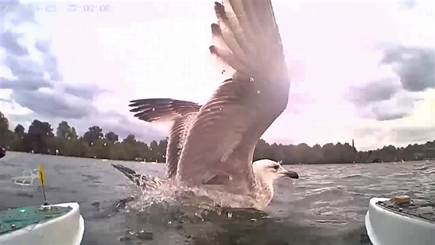Aerial robotics
Friendly visitor
The SailMAV drone can fly and sail on water due to its foldable wings. Its special design also allows it to record wildlife behavior, as animals do not perceive the drone as a hostile intruder.

Gliding along quietly and still getting to your destination – research can be that simple. The ultralight SailMAV drone flies to remote waters and sails there quietly, saving energy. In this way, the small flying robot (Micro Aerial Vehicle, or MAV) can collect data on the biodiversity of, say, a remote alpine mountain lake or an Arctic fjord. "Water birds or mammals on the shore are not disturbed by SailMAV, so the drone can make unbiased statements about the effects of climate change on the state of the ecosystem, for example," explains André Farinha.
Farinha is one of the drone's developers, a team of researchers from Empa's Sustainability Robotics Laboratory in Dübendorf and the Aerial Robotics Laboratory at Imperial College London. Their challenge: to teach the sailing drone to fly, even though the design specifications for movements on the water and in the air are contradictory. Says Farinha, "We were finally able to optimize the aerodynamic properties after mathematical modeling and building a few prototypes so that SailMAV can actually sail on the water like a catamaran and fly with its wings wide open."
To enable the small drone to manage the change of location from one body of water to the next, it folds the sides of its three-part high-performance wing into a horizontal position within two seconds, giving it a wingspan of just under a meter. Farinha's team constructed the flying robot from polymer foam with a tenth-of-a-millimeter-thin carbon shell and coated it with a water-repellent nanoparticle layer. As a result, SailMAV weighs just 520 grams. Under lab conditions, the fast and agile drone makes the transition from water to air in just a few seconds and within a distance of less than ten meters.
The researchers are now working on ensuring that SailMAV can also do this under real-world conditions in wind and weather. In future, SailMAV will also be equipped with more complex sensors that will allow the inconspicuous bird friend to fly and sail autonomously.

A drone for every occasion
Empa researchers are developing drones for all aspects of the environment, represented as the four "elements" of fire, water, earth and air. Illustration: Empa
Prof. Dr. Mirko Kovac
Laboratory of Sustainability Robotics
Phone: +41 58 765 4689


Empa Quarterly#79 Aerial robotics
They fly through fire, sneak past birds, and collect data from the heart of rainforests without leaving a trace: In the current issue, we feature drones with unusual capabilities. In the planned "DroneHub," researchers want to develop and test even more versatile flying robots. And for those who prefer to keep their feet firmly on the ground, the issue also features research projects on quantum technology, medicine, building materials and green electronics.
Read the EmpaQuarterly online or download the pdf-version.

|
A "spy" in the belly |
|
To ensure that wounds in the abdominal cavity remain tightly closed after an operation, researchers have developed a patch with sensors. The polymer patch reports dangerous leaks at sutures in the gastrointestinal tract and closes the sites automatically. |
|
Research accelerator |
|
The researchers of Empa's Surface Science and Coating Technologies laboratory aim to accelerate the development of multifunctional thin films, which could be applied in electronic devices or high-performance optics. |








